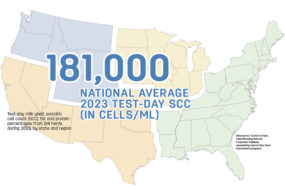Last week, the USDA released its final rule updating meal standards for the National School Lunch Program (NSLP) and the School Breakfast Program (SBP). The updated rule encompasses three key victories for dairy and child nutrition, and has drawn applause from industry stakeholders.
Flavored milk for all grades
One major aspect of the updated rule is the preservation of the option for schools nationwide to serve flavored milk to students in all grades, provided the product adheres to the Healthy School Milk Commitment guidelines. This commitment ensures an 8-ounce half-pint of nonfat or low-fat flavored milk contains no more than 10 grams of added sugar per serving.
After establishing the commitment in early 2023 with 37 school milk processors, the International Dairy Foods Association (IDFA) reported the current average added sugar level is 7.5 grams per serving for flavored milk in schools.
“Thanks to the leadership of America’s milk processors, flavored milk in schools today is fully consistent with the latest federal dietary guidelines. These options provide the same 13 essential nutrients as unflavored milk, reduce plate waste and encourage greater meal participation,” said Michael Dykes, DVM, president and CEO of the IDFA.
“This final rule helps ensure kids will be able to choose a nutritious milk they tend to prefer,” said Gregg Doud, CEO and president of the National Milk Producers Federation (NMPF). “Many children prefer low-fat flavored milk over fat-free, and flavored milk offers the same nutrients as regular milk with a minor amount of added sugar.”
Lactose-free milk a viable option
Additionally, the rule reemphasizes lactose-free milk as a viable option in all reimbursable meals, marking a significant stride toward promoting health and nutrition equity among schoolchildren.
A recent checkoff-led pilot program that offered lactose-free chocolate milk in Cincinnati schools showed how this option can increase consumption and reach students who aren’t drinking milk because of real or perceived lactose intolerance.
The National Dairy Council (NDC) and American Dairy Association Mideast worked with Cincinnati Public Schools (CPS) to offer the country’s first single-serve lactose-free chocolate milk package to six elementary and four high schools in the fourth quarter of 2023. Because of the program’s success, it was expanded to include all 15 CPS high schools through June of this year.
When compared to the rest of the Cincinnati district, the pilot schools experienced a 16% increase in milk consumption and 7% higher meal participation.
Tracy Enslen, vice president of business development for American Dairy Association Mideast, said she hopes the program’s success catches on elsewhere across the country with schools and processors.
Sodium, added sugar targets
Another key provision of the USDA rule is the maintenance of current school meal sodium targets through the school year 2026-27, followed by the adoption of a more achievable and permanent target. This measure aims to preserve cheese as a healthy component of school meals.
It also introduces added sugar maximums for flavored yogurt and flavored milk beginning with the 2025-26 school year, followed by a weekly menu-wide limit of an average of less than 10% of calories per meal from added sugars beginning with the 2027-28 school year.
Missed opportunity for whole, 2%
Despite these strides, both IDFA and NMPF continue to advocate for further enhancements in school meal offerings, including the restoration of whole and 2% milk varieties.
“USDA also missed an opportunity to restore 2 percent and whole milk to school breakfast and lunch. A plethora of science demonstrates dairy fat is unique, unlike typical saturated fats, in delivering positive and neutral health outcomes to people across all demographics,” Dykes said.
Both groups expressed support for the Whole Milk for Healthy Kids Act (H.R. 1147/S. 1957), which would restore whole and 2% varieties to school lunch menus. The legislation overwhelmingly passed the House of Representatives in December and awaits Senate approval.






